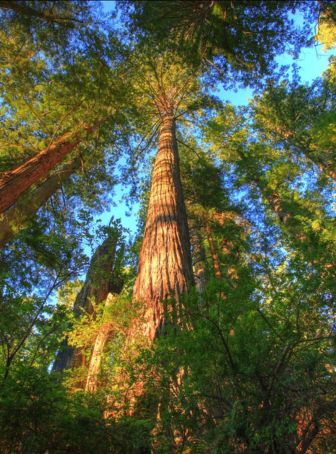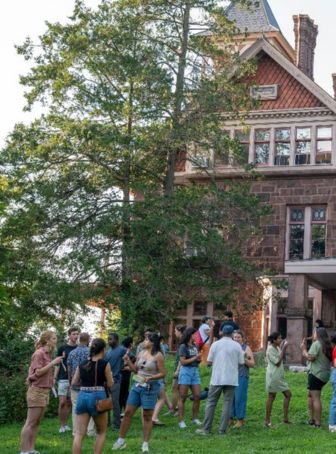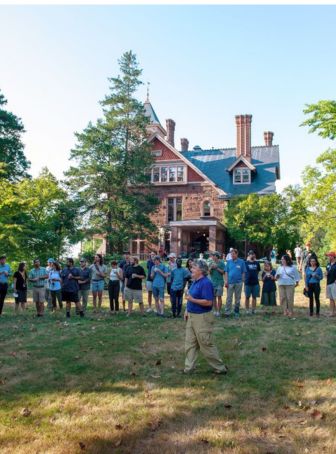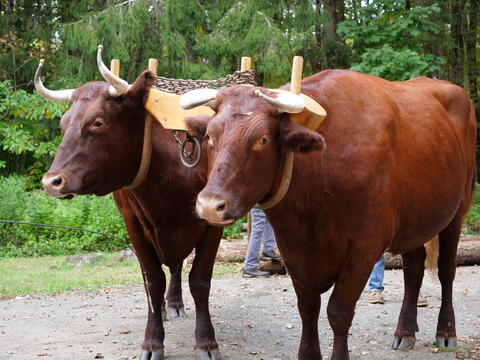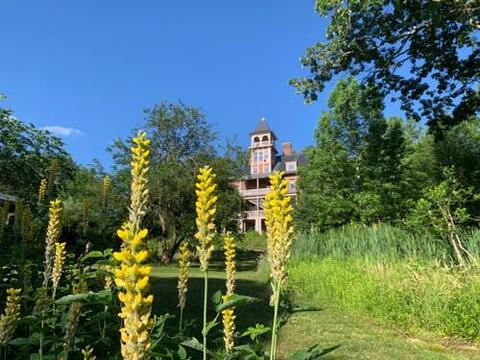
By Jess Jones ‘23 MF
Trees, in their wild diversity, are rather communal creatures. Through their roots, they share sugars beneath the ground. With their sturdy boles and branches, they shelter each other from the wind. The diversity of a forest often correlates with the individual tree’s resistance to disease and the collective’s resistance to disturbance. Those who run forest restoration projects around the world know to focus on fostering wonderfully diverse wooded communities. When it comes to the ecosystem, biodiversity is the root of resilience.
I find myself maintained in no small part by rich, mutually-rooting relationships. When the storms come (they always do), do you engage in this mutual-rooting, too? It seems that what breathes life into a forest breathes life into human communities. I spoke with a number of alums, faculty, and current students at The Forest School at Yale School of the Environment to get a better picture of what community means in our community. Here I’ll share the remarkable stories and work of some of our companions.
“Community is what holds us and what holds us accountable,” I interviewed Niko Alexander ‘18 MF/MBA over a Zoom call. Thick California sunshine and the crowns of trees flitted around him. He was on land stewarded by Shelterwood, a collective he co-founded. In their own words, Shelterwood is “a Black, Indigenous, LGBTQ-led community forest and retreat center, healing people and ecosystems through active stewardship and community engagement.”
Speaking to Niko, it was clear that he puts great value on intentional relationships, human or otherwise. When he arrived at YSE to study forestry and business, he at times dealt with imposter syndrome and feeling left out as a queer person of color. He took the time to learn all the oaks of New Haven – a return to roots, if you will. Post oak, red oak, black oak. Here, he found kin and felt like he was “returning to circle.” Quercus ilicifolia, quercus alba, quercus bicolor. Listening to him, I could imagine those oaks leaning over an East Rock stream, their leaves mirrored on the water’s surface as a belted kingfisher calls from a nearby log.
Shelterwood is more than a place to advance individual learning. It’s an opportunity to be in an intentional relationship with space – a relationship allowed through the open invitation to arrive as one’s full self. “When we are navigating and questioning identity, we can’t do the work we need to do to address the great unraveling.” This is the great unraveling: the sixth extinction, the climate crisis, food insecurity, the whole lot of it. We can be our own examples in navigating this.
Students may have noticed an IRB-approved food insecurity survey floating around group chats and emails and posters promoting a Town Hall meeting on food security at YSE. This was organized by a number of students, among them Kiera Quigley ‘23 MEM. She and six other students took Lecturer Edward Ian Robinson’s course “Organizing: People, Power and Change” this past spring semester. Through this course, she and her colleagues organized a series of actions to assess the state of food insecurity at YSE, gather intel on community needs, and present administration with a plan to address student food insecurity. Students dealing with hunger are less able to show up and participate in their studies, and we are all the poorer for it.
Many institutions are already doing work to address food insecurity, like University of Michigan. The group of students are advocating for the installation of a community pantry or “free fridge” which can offer students free, culturally relevant foods in private locations. In a petition Kiera and her colleagues put out, they received over 50 signatures for this proposal in only two days. The student-led initiative to address food insecurity at YSE is ongoing and projected to continue into the next semester. Their goal is to get a commitment from YSE administration to create, fund, and maintain this pantry. This form of institutional support for (often) low-income, first generation, and food insecure community members will be for the betterment of all.
Jayson Velasquez ’23 MESc is a fellow with the Justice, Equity, Diversity, and Sustainability Initiative (JEDSI). Through his work, he has developed a nuanced understanding of the state of diversity, equity, and inclusion (DEI) at YSE. He calls for the continuation of the work which is diversifying the student body at YSE and a “dedicated space for people who identify as first-generation and low income to build community.” These spaces can lead to “healing and student advocacy.” In advocating for community wellbeing, Jayson notes that “the preservation of one’s peace is of utmost importance while working to develop these spaces alongside staff and faculty.”
In December, a Black YSE student was confronted aggressively in Sage Hall by a security officer. Events like this damage that trust we have to show up as ourselves to school, a place where students need to feel safe. Students convened in early March to join a conversation around policing and security on campus with Dean Indy Burke, Assistant Dean of Student Affairs Andrés Fernández Álvarez, other faculty and staff members, as well as the Chief of Police Ronnell Higgins. For the sake of anonymity, I will not divulge the conversations held in that meeting. I will say, however, that we have an inspiring student body who is not afraid to advocate for our own safety and wellbeing.
“We sometimes have the misconception that a healthy community is free from conflict. But really, it’s healthy ways to work through conflict that make a community,” says Michelle Lewis ’13 MESc/M.Div. She founded the Peace Garden Project as a way to take responsibility in creating healthy communities. In the Project’s gardens, people come together to “care for something other than themselves, which changes how one views the world… We are not just consumers. We are providers, growers, caretakers, conveners, and builders of healthy communities.”
Michelle shared with me that when it comes to building community, there is a difference between opening space and radical hospitality. Radical hospitality asks people to come in, be as they are, and engage in mutual learning, she explained. Our community is growing more diverse, in large part to the dedicated effort of faculty like Dr. Dorceta Taylor ’85 MFS, ’91 PhD, senior associate dean of diversity, equity, and inclusion and professor of environmental justice at YSE. Now is the time to reflect on the difference between calling someone to the table and pulling out a chair.
Lovinia Reynolds ‘22 MEM is a recent graduate, who served as a co-lead for Roots, a Student Interest Group for students of the African Diaspora. Lovinia helped build an anchoring community amongst us Black students at YSE. Between her studies of the energy system, she organized and led many events like art shows, rock climbing, and more. For her, “Roots is a place where Black students in the YSE community feel supported and cared for.” She “gets a lot of joy and satisfaction in creating spaces where people are able to relax, connect, or explore something new. If I had to give that feeling a color, it would be amber.”
The Forest Summer Apprenticeship Program, known as Forest Crew, is a time-honored program in The Forest School. I sat down with Hannah Andrews ‘22 MF after our silviculture class, where she is a teaching assistant. Hannah participated in Crew during the summer of 2021. A big smile grew beneath her mask and her eyes lit up as she began telling me about her summer with the Crew. “People were comfortable being vulnerable and humble. Everyone was open to learning, there was no competition or need to pose.” For Hannah’s year, the Crew was a place where students could finally be together after a long year online during the pandemic. A look of peace came over her as she recounted to me her early mornings spent in Adirondack chairs overlooking camp, sipping on coffee with her friends and crewmates. Crew member Emily Sigman ‘21 MF/MA created centering exercises based on meditation for crew members as they were cruising the woods. Emily also wrote a beautiful article on the experience linked here.
Hannah and I lamented on how on campus and in society at large, it’s easy to feel our worth is tied to our production. Overworking oneself is rewarded – at least in the short term. Feelings of burnout are exacerbated when we don’t live up to our own expectations. Hannah told me how she would like to carry the attitude of the Crew – the openness, the magic, the fun, the community – to campus. When we take care of ourselves, it’s easier to show up for each other in class and beyond.
We should all have environments where we can recharge. Lecturer Marlyse Duguid feels that nature plays a big role in her wellbeing, yet not big enough. “It can be hard to prioritize nature.” I find this relatable – in the rush of midterms, a tree is less the place to rest your head and more likely the subject of intense scrutiny and abstraction. As a graduate of the program herself, many students such as myself feel comfortable coming to Marlyse. She has gleaned some patterns over the years. “Our culture gives us so much to do and makes self-care your responsibility – like an extra job.” To combat this, Marlyse integrates time in nature with the courses she teaches at The Forest School. For example, students in the course “Forest Dynamics” undertake a semester-long “Place in the Woods” assignment. Students choose a spot in the forest to spend time weekly and take note of the ecological changes over time. It is a quiet space of reflection, where we can synthesize our knowledge from the books and see it play out in the full color of the real world.
Structural changes to the School can help foster community. One such change has been the introduction of new staff member Mia Wilson, the embedded counselor and mental health provider for both YSE and the Law School. She believes that “community well-being starts with building a safe place for students, faculty, and staff to communicate their needs and have easy access to mental health resources.” She brings students free short-term individual therapy, art therapy, and group sessions among other offers. Her hope is that “students feel safe and comfortable seeking mental health treatment in a less formal way.” Mia wants students to know that they aren’t alone.
Raffa Sindoni ‘23 MEM is a student who works closely with Mia and the Good Life Center, a student wellness center attached to larger Yale University. He wants to cultivate a community defined by intention to create, play, and bring lightfulness. He asks, “How can we create things that last?” Raffa started Heartseed in the fall of 2021 at the Good Life Center, with a mission to grow resilient communities in this time of climate crisis. As curriculum director of Heartseed, he hosts events at YSE and Yale including poetry workshops in Sage Lounge, meditation classes, and reading groups on books like All About Love by bell hooks. As he sat back in his office chair, with a mellow, soft and gray light coming in through the cracked window, I asked him what he wants people to know. He said, “it’s important as grad students to remember that this place may be transitory for us, but that our impact on others is not. How we show up with the people in our life here changes us and them.”
I’d like to thank Lovinia Reynolds, Mia Wilson, Jayson Velasquez, Niko Alexandre, Michelle Lewis, Hannah Andrews, and Raffa Sindoni for their time in writing this piece. I would also like to thank my colleagues on the TFS communications team Sara Santiago and Isaac Merson for supporting this piece and helping me to edit it. Finally, I’d like to thank all those who foster community in their respective places.
